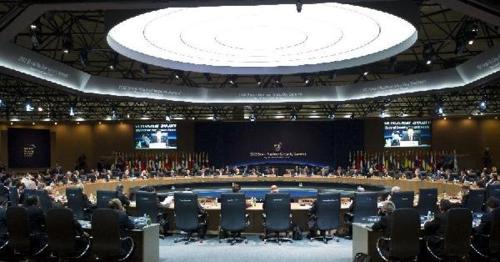I just returned from a week in South Korea to attend a large nuclear industry conference and a few events related to the Nuclear Security Summit. I had low expectations for the outcome of the Summit, and the communiqué released following the Summit certainly did not contain any pleasant surprises.
There is absolutely no indication that the international community is willing to grapple with the fundamental problem that has led to the situation we are in today: namely, the fact that too many countries continue to invoke “national sovereignty” to thwart the creation of effective international instruments to help control the nuclear terrorism dangers of plutonium, highly enriched uranium and other weapon-usable materials. This attitude is blocking the development of policies to effectively protect bomb-usable materials that have already been produced and to stop compounding the problem by producing more of them.
South Korea and Pyroprocessing
And of course no one took on the elephant in the room – namely, South Korea’s desire to negotiate a renewed agreement for nuclear cooperation with the United States that would include U.S. advance consent for South Korea to develop an indigenous capability for spent fuel reprocessing, using a technology known as “pyroprocessing.” Promoters of this technology have long asserted that this technology does not separate plutonium in a purified form and is therefore proliferation- and terrorism-resistant. However, numerous authoritative technical analyses have demonstrated that this assertion simply is not true, as this blog has previously documented.
South Korea certainly deserves praise for volunteering to host the Nuclear Security Summit and helping to sustain the process and maintain an international focus on nuclear terrorism. However, if I were the cynical sort, I would suspect that South Korea made the offer as a way to suppress any criticism (at a very sensitive time in its negotiations with the U.S.) of its own push to develop domestic reprocessing facilities that could increase the global stockpile of vulnerable weapon-usable materials and the risk of nuclear terrorism. If that was the strategy, then it certainly appears to have worked.
At the Pacific Basin Nuclear Conference (PBNC) in Busan, speakers from the Korea Atomic Energy Research Institute (KAERI) presented one paper after another on South Korean pyroprocessing development. Although South Korea is not currently authorized to conduct domestic reprocessing activities on irradiated fuel, it is allowed to develop technologies using surrogate materials such as depleted uranium, and it appears that it is going full steam ahead within its current limitations. It is working to optimize certain troublesome aspects of the pyroprocessing process that could greatly facilitate its ability to carry out rapid, industrial-scale pyroprocessing on irradiated fuel should it receive advance consent from the U.S. to do so. Thus one can look at its current program as providing a latent capability to efficiently separate weapon-usable materials should it get the go-ahead to begin hot operations.
KAERI officials continue to deny that pyroprocessing presents any significant proliferation or terrorism risks, citing the fact that the process produces a mixture of plutonium, uranium and other actinides during normal operations, and that this product has a high radiation barrier. Upon questioning, KAERI representatives said that they were unfamiliar with the results of the U.S. national laboratory study by Charles Bathke and collaborators that concluded that group separation of plutonium with other transuranic (TRU) elements resulted in products that are attractive for nuclear weapons use. This result should not have been a surprise in any event given that other TRU isotopes, such as neptunium-237 and americium-241, are themselves weapon-usable materials.
Even worse, KAERI has made its own modifications to the pyroprocessing process that further reduce any benefits over conventional reprocessing with regard to theft resistance. Although pyroprocessing advocates assert that the plutonium-bearing product of pyroprocessing is resistant to theft because of a high radiation barrier, it has long been known that this radiation barrier – which is only marginal at the outset – is provided almost entirely by the rare earth isotope cerium-144. However, it is undesirable from a reactor physics point of view to allow high concentrations of rare earth elements to remain in fresh reactor fuel. For that reason, KAERI has developed a process known as “residual actinide recovery” that would separate the rare earth elements from the plutonium-bearing product prior to fresh fuel fabrication. This would further reduce the cerium-144 concentration and the radiation barrier that it provides, rendering the fresh fuel nearly as vulnerable to theft as MOX fuel fabricated with separated plutonium.
South Korea is currently engaged in a 10-year “joint study” with the United States on pyroprocessing, which allows Korean scientists to participate in experiments on irradiated fuel that are conducted in the United States, including an “integrated process demonstration.” However, the terms of this study, including issues like how the South Korean visitors will actually participate in these studies, are not clear. At PBNC, a speaker from KAERI said that for one part of the study – “head-end” activities designed to convert oxide spent fuel into a metallic form suitable for pyroprocessing – KAERI would “take the lead.” It is unclear what this actually means. Obviously, there is significant potential in this arrangement for KAERI personnel to obtain significant operating experience at U.S. facilities they could then transfer back home.
US Progress (or lack thereof)
UCS firmly believes that the U.S. lacks the authority to lecture the rest of the world about fissile material security unless it practices what it preaches back home. However, as we have documented in blog posts going back to the time of the first Nuclear Security Summit, the U.S. continues to take actions to weaken, rather than to strengthen, security over domestic nuclear facilities and materials.
First and foremost were changes made by the Nuclear Regulatory Commission (NRC) in recent years to its regulations governing physical protection of plutonium. These changes reduced the required level of security for plutonium-bearing MOX fuel at nuclear reactor sites, exempting reactor security forces from the obligation to protect MOX fuel from the “design basis threat” for theft.
In addition, the NRC continues to contemplate additional changes that would extend these security reductions to MOX fuel and certain plutonium compounds at all facilities, including fuel cycle facilities such as MOX fabrication plants, as well as to transport between facilities. In particular, weakening the transport requirements could allow MOX fuel to be shipped in ordinary trucks, as it is done in France, instead of in special vehicles, known as Safe Secure Trailers (SSTs), that are used by the National Nuclear Security Administration (NNSA) to transport nuclear weapons and weapon-usable materials.
While weakening security on MOX fuel, the NRC continues to refuse to strengthen security requirements on weapon-usable materials such as neptunium-237 and americium-241. Even though such materials are now generally acknowledged to be comparable to uranium-235 in their potential for use in nuclear weapons, the NRC does not currently require them to be governed by stringent security or material accounting requirements.
The NRC has also approved the use of certain “alternate methods” to meet physical protection requirements at the MOX fuel fabrication plant under construction at the Savannah River Site. Although the details are classified, one can speculate that the applicant would not have requested the use of alternate methods unless it contended that the regulations as written were too burdensome and unnecessarily conservative. By granting these exemptions, the NRC has sent the wrong signal to Russia, which is currently building its own MOX fuel fabrication facilities to fulfill its obligations under the bilateral plutonium disposition agreement.
This is particularly irksome given that the number one pledge that the U.S. cited in its progress report since the 2010 Washington Nuclear Security Summit (NSS) is the so-called “entry into force” of the bilateral U.S.-Russian Plutonium Management and Disposition Agreement. The report also takes credit for incorporating “security by design” features in the MOX plant as part of its response to the 2010 NSS Work Plan. Yet trying to fulfill the plutonium disposition agreement on the cheap has led directly to the security corner-cutting that has gone on within the MOX program and has been supported by NNSA. And as UCS has pointed out before, the contractor building the MOX plant asserted before an NRC licensing board panel that there was no regulatory requirement to incorporate security features into the MOX plant design.
The U.S. Progress Report (p. 315) also boasts that “the US adjusted design basis threats and implemented new materials control and accounting, physical protection, and information security policies based on new vulnerability assessments.” The report does not point out that this “adjustment” actually represents a significant downsizing of protective forces (5%) at NNSA facilities possessing Category I special nuclear materials in an attempt to lower the costs of the security enhancements that were put into place after the 9/11 attacks.
With regard to physical protection at nuclear power plants against sabotage, the adequacy of current security measures in the U.S. is still not clear. As I show in a recent paper, U.S. nuclear power plants fail force-on-force security tests at a rate of about 10% per year.
Evidence has recently emerged that the nuclear industry may be trying to affect how these tests are conducted, possibly to increase its success rate. The Nuclear Energy Institute has written a draft guidance document, NEI 11-02, that appears to put restrictions on the ability of the mock adversary force to use weapons and tactics during the exercises that were not previously used but are within the scope of the design basis threat. (The document itself is not public, but a set of comments by NRC staff on the document has been made public.)
This goes to the crucial issue of the realism of the tests. The mock adversary force should be free to utilize any weapon or tactic within the scope of the design basis threat without prior notification of plant operators. Otherwise, plant security forces may become too accustomed to protecting against familiar threats and may not be flexible enough to respond to the unexpected. But, as it has often been pointed out before, in a real attack, terrorists will not consult with plant security beforehand to make sure that they do not try anything that security officers do not expect! The NRC should not allow NEI to dictate the terms under which these crucial exercises are conducted.

